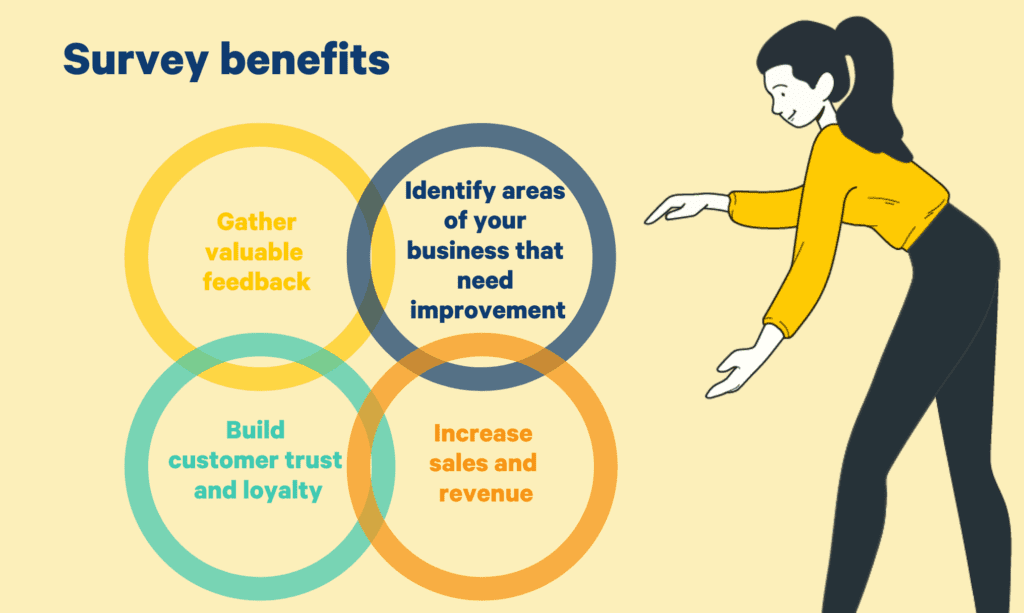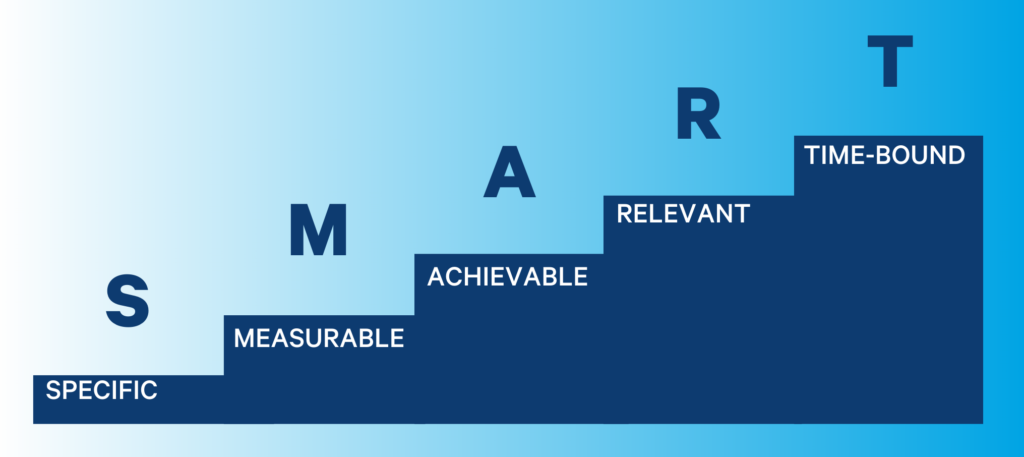11 Questions Sur La Satisfaction Des Clients Que Vous Devez Vous Poser

Pour pouvoir réaliser un excellent sondage de satisfaction client, vous devez vous poser ces questions sur la satisfaction client à vous-même.
Si vous avez l'impression que je suis fou, laissez-moi développer un peu.
La satisfaction du client est l'un des objectifs les plus importants qu'une entreprise puisse avoir. C'est aussi l'une des choses les plus difficiles à réaliser.
Par conséquent, avant de demander à vos clients de consacrer du temps à répondre à votre sondage, vous devez vous assurer que vous ne leur faites pas perdre leur temps. De nombreuses personnes conçoivent des sondages sans réel objectif. Ils incluent des questions non pertinentes qui ne mènent pas à des informations exploitables. En conséquence, ils se retrouvent avec des données inutiles.
Pour créer un sondage de satisfaction client efficace, vous devez vous poser les bonnes questions. Dans cet article, nous allons passer en revue :
- L'importance de la satisfaction du client en 2024
- 11 questions sur la satisfaction du client à se poser
- Une méthode simple en 5 étapes pour mesurer la satisfaction des clients
Formons une base solide de l'importance de la satisfaction du client.
L'Importance De La Satisfaction Du Client En 2024
De nombreuses entreprises se posent encore la question suivante : "Pourquoi la satisfaction des clients est-elle importante ? Nous fournissons un produit/service de qualité ; que veulent-ils de plus ?"
La réponse à cette question est que la satisfaction du client est la clé d'une entreprise durable et prospère.
Un client heureux est un client fidèle.
Et un client fidèle reviendra et achètera de nouveau. Ce sont également eux qui parleront de votre entreprise à leurs amis et à leur famille.
D'autre part, les clients mécontents sont ceux qui partiront et ne reviendront jamais. Ils parleront aussi de votre entreprise à leurs amis et à leur famille, mais de façon négative.
Les cinq points ci-dessous résument parfaitement les raisons pour lesquelles vous devez prêter attention à la satisfaction des clients :
- Fidélisation des clients
- Vous économisez de l'argent
- Améliore le moral des employés
- Renforcer votre réputation
- Favoriser l'innovation
Examinons ces cinq raisons d'un peu plus près.
1. Favorise La Fidélisation Des Clients
L'une des principales raisons pour lesquelles la satisfaction des clients est cruciale pour les entreprises est qu'elle conduit à des clients fidèles.
Selon les recherches, "la satisfaction du client est un facteur déterminant direct de la fidélité du client, qui, à son tour, est un déterminant central de la rétention du client" (Gerpott et al., 2001, p. 253).
Les entreprises qui offrent un niveau élevé d'expérience client ont des clients qui reviennent encore et encore. Ils ont également tendance à dépenser plus d'argent avec l'entreprise et sont plus susceptibles de recommander l'entreprise à d'autres personnes.
2. Vous Economisez De L'argent
Il est plus coûteux pour les entreprises d'attirer de nouveaux clients que de conserver les clients existants. En fait, "l'acquisition d'un nouveau client peut coûter cinq fois plus cher que la fidélisation d'un client existant".
En outre, une "augmentation de 5 % de la fidélisation de la clientèle produit une augmentation de plus de 25 % des bénéfices".
Mais pourquoi ?
Les clients fidèles sont plus précieux pour les entreprises car ils connaissent déjà l'entreprise et lui font confiance. Ils préfèrent payer un supplément pour un produit ou un service qu'ils connaissent et apprécient plutôt que de tenter leur chance avec une nouvelle entreprise.
3. Améliore Le Moral Des Employés
Vous vous demandez peut-être comment des clients satisfaits se traduisent par un moral élevé des employés ?
La réponse est simple. Lorsque les employés voient que leur entreprise s'attache à satisfaire les besoins des clients, ils se sentent bien dans leur travail. Ils ont le sentiment que leur travail a de la valeur et que leur entreprise se soucie de ses clients.
La Harvard Business School a montré que le fait d'avoir un niveau élevé de satisfaction de la clientèle peut accroître la satisfaction des employés.
4. Améliore Votre Réputation
La réputation d'une entreprise est l'un de ses actifs les plus précieux. Il faut des années pour se forger une bonne réputation, mais seulement quelques mauvaises expériences pour la perdre.
En fait, il faut 12 expériences positives pour compenser une expérience négative.
Lorsque les clients sont satisfaits, ils parlent à d'autres de leurs expériences positives. Saviez-vous que le bouche-à-oreille est l'une des formes de marketing les plus efficaces, car il provient d'une source fiable. Il permet de promouvoir non seulement vos produits et services, mais aussi la réputation de votre marque.
5. Favorise L'innovation
L'innovation est une force primaire qui permet aux entreprises de rester en tête de la concurrence et de garder leurs clients heureux. Don Peppers, fondateur du groupe Peppers & Rogers, déclare :
"Les clients sont le lien entre le profit que vous faites aujourd'hui et le profit que vous êtes susceptible de faire demain. La relation client relie directement les bénéfices et les coûts d'aujourd'hui à la valeur globale pour l'actionnaire de votre entreprise."
En d'autres termes, si vous voulez augmenter vos bénéfices, vous devez vous concentrer sur la satisfaction du client.
En écoutant les commentaires des clients et en y donnant suite, les entreprises peuvent garder une longueur d'avance sur la concurrence et continuer à améliorer leurs produits et services. Ce qui, à son tour, conduit à des clients encore plus satisfaits.
Résumons donc tout ce que nous avons appris dans cette section.
- La satisfaction du client est cruciale car elle permet de fidéliser les clients.
- Les clients satisfaits sont plus enclins à revenir et à dépenser davantage.
- Lorsque les employés voient que leur entreprise se concentre sur la satisfaction du client, ils se sentent bien dans leur travail.
- La réputation d'une entreprise est influencée par l'expérience client qu'elle offre.
- L'innovation est essentielle pour les entreprises afin de rester en tête de la concurrence et de satisfaire leurs clients.
Maintenant que nous connaissons l'importance de la satisfaction des clients, voyons comment la mesurer.
11 Questions Sur La Satisfaction Des Clients Que Vous Devez Vous Poser
La création de sondages de satisfaction client peut être une tâche ardue. Il y a beaucoup d'éléments à prendre en compte, comme le type de questions à poser et la façon de les formuler.
En outre, vous devez vous assurer que le sondage est suffisamment court pour que vos clients y répondent, mais suffisamment longue pour que vous obteniez des informations utiles.
Nous avons donc dressé une liste de 11 questions que vous devez vous poser lors de la conception d'un sondage de satisfaction client.
- Quel est l'objectif du sondage ?
- Quels sont les objectifs que vous cherchez à atteindre ?
- Qui est votre public cible ?
- Comment atteindre votre public cible ?
- Quel type de questions de sondage sur la satisfaction des clients devez-vous inclure ?
- Quelles sont les informations que vous devez collecter ?
- Comment allez-vous utiliser les résultats des sondages de satisfaction des clients ?
- Comment allez-vous vous assurer que le sondage est impartial ?
- Comment allez-vous garantir la confidentialité du sondage ?
- Quels sont les risques liés aux sondages ?
- Quels sont les avantages de la réalisation du sondage ?
En gardant ces questions à l'esprit, vous pourrez créer un modèle de sondage de satisfaction client efficace et utile pour votre entreprise.
1. Quel Est L'objectif Du Sondage ?
La première question que vous devez vous poser est "quel est l'objectif du sondage ?". En répondant à cette question, vous déterminez le type de questions à poser dans le cadre du sondage de satisfaction client et les informations que vous souhaitez recueillir.
En ayant un objectif clair, vous commencez à éliminer les questions qui ne sont pas pertinentes et à vous concentrer sur celles qui vous aideront à atteindre vos objectifs.
Supposons que vous souhaitiez savoir ce que vos clients pensent de votre service clientèle. Dans ce cas, votre sondage pourrait se concentrer sur des questions concernant la qualité du service à la clientèle et le degré de satisfaction des clients à son égard.
En outre, vous n'êtes pas obligé d'inclure des questions concernant d'autres sujets tels que la qualité du produit ou le prix.
2. Quels Sont Les Objectifs Que Vous Cherchez A Atteindre ?
Il peut sembler que le but et les objectifs soient les mêmes, mais il existe une différence subtile. L'objectif est davantage axé sur les informations que vous souhaitez recueillir. En revanche, les objectifs sont davantage axés sur ce que vous voulez faire de ces informations.
En revanche, les objectifs sont davantage axés sur ce que vous voulez faire de ces informations.
En outre, vos objectifs doivent être spécifiques, mesurables, réalisables, pertinents et limités dans le temps.
Par exemple, votre objectif peut être d'augmenter la satisfaction des clients de 10 % au cours des six prochains mois. Ou encore de viser un taux de recommandation net plus élevé d'ici le prochain trimestre. Pour atteindre ces objectifs, vous devez collecter des données pertinentes qui vous aideront à comprendre quels changements doivent être effectués.
3. Qui Est Votre Public Cible ?
Imaginez donc que vous ayez déterminé l'objet et le but de votre sondage. Vous avez même conçu le questionnaire pour qu'il s'aligne sur l'identité de votre marque.
Cependant, vous ne savez pas exactement qui est votre public cible. Il s'agit d'une erreur courante que de nombreuses entreprises commettent lorsqu'elles réalisent des sondages auprès de leurs clients.
Ne pas identifier votre public cible peut conduire à deux problèmes principaux :
- Vous risquez de perdre du temps et des ressources à sonder des personnes qui ne sont pas intéressées par vos produits ou services.
- Vous risquez de ne pas collecter suffisamment de données auprès d'une partie importante de votre clientèle, qui se sentira alors peu écoutée et non représentée.
En outre, vous devez également vous assurer que vous touchez les gens au bon moment dans leur parcours client. Par exemple, si vous voulez savoir dans quelle mesure les gens sont susceptibles de recommander vos produits ou services, il ne serait pas judicieux d'interroger des personnes qui viennent d'acheter votre produit.
Ils n'ont pas encore eu le temps de se faire une opinion. Il serait plus avantageux de sonder des personnes qui utilisent votre produit ou service depuis un certain temps.
En revanche, si vous voulez savoir ce que les gens pensent de votre produit avant de l'acheter, il serait plus avantageux de sonder des personnes qui sont en train d'acheter.
4. Quel Est Le Meilleur Moyen D'atteindre Votre Public Cible ?
Une fois que vous avez déterminé qui est votre public cible, la prochaine question que vous devez vous poser est la suivante : "Comment puis-je les atteindre ?" Il y a plusieurs façons de procéder.
Vous pouvez atteindre votre public cible directement par courrier électronique, sur les réseaux sociaux ou même en personne.
Vous pouvez également opter pour une voie indirecte, via des sociétés d'études de marché ou des panels en ligne.
Vous pouvez également utiliser une combinaison de méthodes directes et indirectes.
Trustmary vous permet d'atteindre et d'importer des avis à partir de diverses plateformes.
Ne pas prévoir comment atteindre votre public cible peut entraîner plusieurs problèmes.
Par exemple, si la plupart de vos clients achètent en ligne mais que vous n'interrogez les gens qu'en personne, vous n'obtiendrez pas une représentation exacte de ce que pense votre clientèle.
Cela conduira à une mauvaise prise de décision et pourrait potentiellement nuire à votre entreprise à long terme.
5. Quel Type De Questions De Sondage Sur La Satisfaction Des Clients Devriez-Vous Inclure ?
C'est un gros morceau.
Le type de questions de sondage sur la satisfaction des clients que vous incluez dans votre sondage déterminera la qualité des données que vous recueillerez.
Les bonnes questions de sondage ne vous aideront pas seulement à prendre des décisions en connaissance de cause, elles permettront également à vos clients de se sentir écoutés.
Le tableau suivant résume plusieurs types de questions de sondage que vous pouvez poser et le type d'informations que vous pouvez espérer recueillir pour chacune d'entre elles.
| Type de question du sondage sur la satisfaction des clients | Informations collectées |
| Questions ouvertes | Des données qualitatives qui peuvent être utilisées pour générer des idées. |
| Questions fermées | Des données quantitatives qui peuvent être analysées et comparées |
| Questions à choix multiples | Des données quantitatives qui permettent une plus grande liberté en termes de choix de réponses. |
| Questions sur l'échelle de Likert | Des données quantitatives qui peuvent être analysées pour comprendre le sentiment des clients. |
Disons que vous voulez demander à vos clients dans quelle mesure ils sont susceptibles de recommander vos produits ou services à un ami.
Une option consiste à utiliser une question fermée et à leur demander d'évaluer leur probabilité sur une échelle de 1 à 10.
Vous obtiendrez ainsi des données quantitatives que vous pourrez analyser et comparer.
Une autre option consiste à utiliser une question à échelle de Likert et à leur donner plusieurs choix de réponses, comme "Très probable", "Probable", "Peu probable" ou "Très peu probable".
Vous obtiendrez également des données quantitatives, mais elles seront plus limitées en termes de possibilités d'utilisation.
Enfin, vous pouvez utiliser une question ouverte et leur demander d'expliquer pourquoi ils se sentent ainsi.
Vous obtiendrez ainsi des données qualitatives que vous pourrez utiliser pour mieux comprendre les besoins des clients.
N'oubliez pas de ne poser que des questions qui apportent une valeur ajoutée et non pour le plaisir de les poser.
Par exemple, ne posez pas de questions démographiques personnelles si vous n'en avez pas besoin. Cela ne ferait qu'agacer le répondant et pourrait l'amener à abandonner complètement le sondage.
6. Quelles Informations Devez-Vous Recueillir ?
Cela rejoint le point précédent.
Avant de commencer à créer votre sondage, vous devez comprendre le type d'informations que vous souhaitez recueillir.
Voulez-vous collecter des données quantitatives ? Des données qualitatives ?
Les deux ?
Vous cherchez à segmenter votre public cible ? Ou voulez-vous calculer le score d'effort du client ? Si c'est le cas, de quel type d'information avez-vous besoin pour le faire ?
Une fois que vous connaissez le type d'informations que vous souhaitez recueillir, vous pouvez créer vos questions.
Si vous n'êtes pas sûr du type d'informations dont vous avez besoin, prenez le temps de faire un brainstorming avec votre équipe.
Quelles décisions devez-vous prendre ? Quel type d'information vous aiderait à prendre ces décisions ?
7. Comment Allez-Vous Utiliser Les Résultats Des Sondages Sur La Satisfaction Des Clients ?
Imaginez un scénario dans lequel vous avez collecté des tonnes de données mais ne savez pas du tout quoi en faire.
Non seulement c'est une perte de temps et de ressources, mais cela peut également conduire à une mauvaise prise de décision.
C'est pourquoi il est important d'avoir un plan clair sur la façon dont vous allez utiliser les résultats du sondage avant même de commencer à les collecter.
Ayez une vision claire de la transformation des données brutes en informations exploitables afin de vous assurer que votre sondage est ciblé et pertinent.
8. Comment Allez-Vous Vous Assurer Que Le Sondage Est Impartial ?
L'une des principales préoccupations des auteurs de sondages de satisfaction client est de s'assurer que leurs sondages sont impartiaux.
Après tout, le but d'un sondage est de recueillir des données objectives qui peuvent être utilisées pour prendre des décisions éclairées.
Cependant, il y a quelques façons dont les préjugés peuvent se glisser dans votre sondage.
Par exemple, vous pouvez utiliser par inadvertance des questions suggestives qui poussent la personne interrogée à donner une réponse particulière. Ou encore, vous pouvez accidentellement utiliser des questions tendancieuses qui contiennent des hypothèses ou des jugements de valeur.
Au lieu de demander : "Le produit était-il défectueux lorsque vous l'avez reçu ?", vous pourriez demander : "Dans quelle mesure êtes-vous satisfait de la qualité du produit ?"
Remarquez la différence entre les deux déclarations.
La première déclaration suppose que le produit était défectueux, tandis que la seconde est neutre.
Il est essentiel d'être conscient du langage que vous utilisez et de revoir soigneusement vos questions avant de les envoyer afin d'éviter tout biais dans votre sondage.
9. Comment Allez-Vous Garantir La Confidentialité Du Sondage ?
La confidentialité est un élément important des sondages de satisfaction des clients.
Après tout, vous demandez aux gens de donner leur avis sincère sur votre produit ou service. Vous pouvez même leur demander de donner leur avis sur leur expérience avec votre entreprise.
S'ils n'ont pas l'impression que leurs réponses resteront confidentielles, ils risquent de ne pas fournir de réponses honnêtes.
Pour garantir la confidentialité, vous devez préciser aux répondants que leurs réponses resteront anonymes.
Faites savoir aux répondants que leurs réponses seront rapportées sous forme agrégée. Aucune information permettant de les identifier personnellement ne sera jointe à leurs réponses.
Ou, si vous envisagez d'utiliser leurs informations, faites-leur savoir précisément comment vous le ferez pour maintenir la transparence.
10. Quels Sont Les Risques Liés Aux Sondages ?
De nombreuses entreprises ne pensent pas aux risques associés à leur sondage. Mais la vérité est qu'il existe quelques risques potentiels dont vous devez être conscient.
Par exemple, vous pourriez accidentellement recueillir des informations sensibles qui pourraient être utilisées pour nuire à vos répondants.
Ou encore, vous pourriez ne pas respecter les lois et réglementations relatives à la confidentialité des données, ce qui entraînerait des amendes coûteuses.
Pour éviter ces risques, il est important de bien comprendre le type d'informations que vous recueillez et de vous assurer que vos répondants ont donné leur consentement.
11. Quels Sont Les Avantages De La Réalisation Du Sondage ?
Pourquoi devez-vous poser cette question ?
Tout simplement, les sondages de satisfaction des clients peuvent représenter beaucoup de travail.
De l'élaboration du sondage à la collecte et à l'analyse des données, il y a beaucoup à faire.
Il est donc essentiel de s'assurer que vous comprenez bien les avantages de l'arpentage avant de vous lancer.

Parmi les avantages de la réalisation de sondages sur la satisfaction des clients, citons les suivants
- Recueillir des informations précieuses qui peuvent être utilisées pour améliorer votre produit ou service.
- Identifier les domaines de votre entreprise qui doivent être améliorés
- Instaurer la confiance et la fidélité des clients
- Augmenter les ventes et les revenus
Question Bonus : Combien De Temps Le Sondage Prendra-T-Il A Etre Administré ?
Si vous prévoyez de mener le sondage en ligne, c'est une question importante à vous poser.

Vous devez vous assurer que le sondage est suffisamment court pour que les gens soient prêts à y répondre, mais suffisamment longue pour que vous puissiez recueillir les informations dont vous avez besoin.
Une bonne règle consiste à limiter la durée du sondage à quelques minutes ou moins. Cela vous permettra d'obtenir le plus grand nombre de réponses possible tout en recueillant les informations dont vous avez besoin.
Dans cette section, nous avons abordé 11 questions importantes que vous devez vous poser avant de réaliser un sondage de satisfaction client.
En posant ces questions, vous pourrez créer des modèles de sondage de satisfaction de la clientèle efficaces qui donneront les résultats escomptés.
Avec le créateur de sondage de Trustmary, vous pouvez créer un modèle de sondage de satisfaction client beau et efficace et l'adapter à vos besoins.
Mesurer La Satisfaction Des Clients : Étape Par Etape
La collecte de commentaires des clients aide les entreprises à suivre et à mesurer la perception des clients. Les sondages sur les réactions des clients sont l'une des méthodes les plus utilisées pour ce faire.
Voici une méthode en 5 étapes que les entreprises peuvent utiliser pour mesurer la satisfaction des clients au moyen de sondages :
- Définissez ce que vous voulez mesurer
- Décidez qui vous voulez interroger
- Choisissez la méthode de sondage
- Analysez les résultats
- Utilisez les résultats pour améliorer la satisfaction des clients
Passons brièvement en revue ces étapes.
1. Définissez Ce Que Vous Voulez Mesurer
Cela peut sembler évident, mais c'est aussi l'étape la plus importante. Vous devez être précis sur ce que vous voulez savoir. Les indicateurs standard de l'expérience client comprennent le score de promoteur net (NPS), le score d'effort client (CES) et le CSAT.
En outre, au lieu de vouloir simplement savoir "à quel point nos clients sont satisfaits", vous pourriez vouloir savoir "à quel point nos clients sont satisfaits de notre nouveau produit".
2. Décidez Qui Vous Voulez Interroger
L'étape suivante : décider quels clients vous voulez inclure dans le sondage.

Pour ce faire, vous pouvez utiliser différentes stratégies, mais le plus important est de veiller à inclure un échantillon représentatif de votre clientèle.
3. Choisir La Méthode D'arpentage
La troisième étape consiste à choisir la méthode ou le canal de sondage. Vous pouvez choisir des canaux tels que le courrier électronique, le téléphone ou les sondages en personne.
Il est essentiel de choisir une méthode qui soit pratique pour vos clients. Sinon, vous risquez de ne pas obtenir un taux de réponse élevé.
4. Analyser Les Résultats
La quatrième étape consiste à analyser les résultats. C'est là que vous devez examiner de près les données et voir ce qu'elles vous disent. Vous devrez utiliser les bonnes formules pour déterminer le score des différentes mesures.
Lors de l'analyse des résultats, il est important d'examiner à la fois les commentaires positifs et négatifs. Vous obtiendrez ainsi une vue d'ensemble de la satisfaction des clients.
5. Utilisez Les Résultats Pour Améliorer La Satisfaction Des Clients
L'étape finale consiste à utiliser les résultats pour améliorer la satisfaction des clients. C'est à ce moment-là que vous devrez prendre en compte le retour d'information et l'utiliser pour apporter des changements à votre entreprise.
Par exemple, supposons que vous constatez que les clients sont mécontents de votre service clientèle. Dans ce cas, vous devrez peut-être apporter quelques changements à votre service clientèle.
En suivant ces étapes, vous pouvez mesurer efficacement la satisfaction des clients et utiliser les résultats pour améliorer votre activité.
Faire De La Satisfaction Elevée Des Clients Un Objectif Réalisable
En résumé, la satisfaction du client est essentielle pour de nombreuses raisons.
Il peut vous aider à augmenter les ventes, à renforcer la confiance des clients et à identifier les domaines de votre entreprise qui doivent être améliorés en temps utile.
Ce billet a mis en évidence une méthode simple en 5 étapes pour mesurer la satisfaction des clients et 11 questions que vous devez vous poser lors de la création d'un sondage de satisfaction client.

Pour résumer, mesurez la satisfaction du client en :
- Définissant ce que vous voulez mesurer
- Décidant qui vous voulez interroger
- Choisissant la méthode d'arpentage
- Analysant les résultats
- Utilisant les résultats pour améliorer la satisfaction des clients
Et lorsque vous concevez vos modèles de sondage de satisfaction client, gardez les questions suivantes à l'esprit :
- Quel est le but du sondage ?
- Quels sont les objectifs que vous cherchez à atteindre ?
- Qui est votre public cible ?
- Comment atteindre votre public cible ?
- Quel type de questions de sondage sur la satisfaction des clients devez-vous inclure ?
- Quelles sont les informations que vous devez collecter ?
- Comment allez-vous utiliser les résultats des sondages de satisfaction des clients ?
- Comment allez-vous vous assurer que le sondage est impartial ?
- Comment allez-vous garantir la confidentialité du sondage ?
- Quels sont les risques liés aux sondages ?
- Quels sont les avantages de la réalisation du sondage ?
Que vous souhaitiez réaliser un sondage sur le Customer Effort Score (CES), le Net Promoter Score ou la satisfaction de la clientèle, ces questions vous aideront à créer un sondage efficace qui promet des résultats positifs pour votre entreprise.
Autres Lectures
Guide Pratique Pour Mesurer Et Analyser La Satisfaction Des Clients En 2022
"Trustmary Nous Aide A Gérer La Satisfaction Des Clients"
Le Sondage Ultime Sur Les Réactions Des Clients (Avec Des Exemples !)
Gérer L'expérience Client Et Se Développer Comme Une Licorne
FAQ
Comment puis-je calculer les scores CSAT à partir des données de mon sondage ?
Le calcul du CSAT dépend du type de question et de réponse que vous utilisez dans votre sondage.
- Si vous utilisez une question "satisfait/non satisfait", vous pouvez calculer le CSAT en prenant le pourcentage de répondants qui répondent "satisfait" et "très satisfait".
- Par exemple, si 65 des 130 personnes interrogées ont répondu "satisfait" ou "très satisfait", votre score de satisfaction client sera de 50 %.
- Si vous utilisez une échelle de 1 à 10, vous pouvez calculer la CSAT en prenant le pourcentage de la "somme des réponses" par rapport à la "note maximale possible".
- Par exemple, si la somme de toutes les réponses est de 750 et que le score maximum possible est de 1000, votre score de satisfaction client sera de 75%.
À quelle fréquence dois-je mener des sondages de satisfaction client ?
La fréquence de votre sondage de satisfaction client dépendra de vos buts et objectifs commerciaux.
Si vous souhaitez utiliser les résultats du sondage pour apporter des changements à votre entreprise, vous devez réaliser le sondage plus fréquemment. Une bonne pratique consiste à mener des sondages une fois par trimestre ou après des changements importants dans votre entreprise.
Vous devriez envisager de mettre en place des sondages de satisfaction client aux principaux points de contact avec la clientèle. Vous pouvez facilement le faire directement à partir de votre CRM.
Comment puis-je améliorer mes scores de satisfaction client ?
Tout commence par l'identification des domaines de votre entreprise qui doivent être améliorés. Pour ce faire, vous pouvez analyser les résultats de votre sondage de satisfaction client.
Une fois que vous avez identifié les domaines à améliorer, vous pouvez commencer à apporter des changements dans votre entreprise. Ces changements peuvent être petits ou grands, mais ils doivent être conçus pour améliorer l'expérience client.
Vous pouvez même demander aux clients quels changements ils souhaiteraient voir dans votre entreprise. Cela peut se faire par le biais d'un sondage de suivi ou en demandant aux clients de donner leur avis lorsqu'ils vous contactent.
Quelles sont les questions courantes d'un sondage sur la satisfaction des clients ?
Voici quelques questions courantes pour les sondages de satisfaction des clients :
- Notre produit/service répond-il à vos normes ?
- Quelle est la probabilité que vous recommandiez notre produit/service à un ami ou à un membre de votre famille ?
- Quelle a été la facilité d'utilisation de notre produit/service ?
- Nos employés ont-ils été utiles ?
- Êtes-vous satisfait de nos prix ?
- Dans quelle mesure êtes-vous satisfait de notre service clientèle ?
- Êtes-vous satisfait de l'expérience globale ?
- Souhaitez-vous voir des changements dans notre produit/service ?
- Y a-t-il autre chose que vous aimeriez nous dire à propos de votre expérience ?
- Souhaitez-vous être contacté par un membre de notre équipe pour discuter de votre expérience ?
- Voulez-vous participer à un sondage de suivi ?
Quelles sont les questions courantes d'un sondage sur la satisfaction des clients ?
L'augmentation des taux de réponse moyens pour votre sondage de satisfaction client peut se faire de plusieurs manières.
- Tout d'abord, assurez-vous que l'objectif du sondage est clair. Faites savoir aux répondants comment leurs commentaires seront utilisés et comment ils contribueront à améliorer votre entreprise.
- Deuxièmement, faites en sorte que le sondage soit aussi court et concis que possible. Les gens préfèrent vaquer à leurs occupations plutôt que de passer du temps à répondre à des questions, alors soyez bref et concis.
- Troisièmement, proposez une incitation à remplir le sondage. Il peut s'agir d'une remise sur un achat futur ou d'une participation à un concours.
- Enfin, faites en sorte qu'il soit facile de répondre au sondage. Si vous utilisez un sondage sur papier, incluez une enveloppe de retour préaffranchie. Si vous utilisez un sondage en ligne, assurez-vous que le lien est facile à trouver et que le sondage peut être complétée en quelques minutes.
